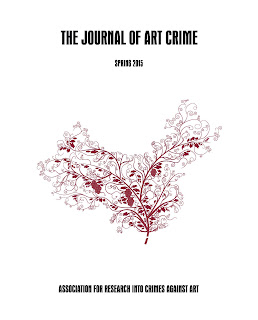Sunday, July 19, 2015 -  China,Spring 2015 issue,the Journal of Art Crime,Toby Bull,wine fraud
China,Spring 2015 issue,the Journal of Art Crime,Toby Bull,wine fraud
 No comments
No comments
 China,Spring 2015 issue,the Journal of Art Crime,Toby Bull,wine fraud
China,Spring 2015 issue,the Journal of Art Crime,Toby Bull,wine fraud
 No comments
No comments
Editorial Essay: Toby Bull's perspective in "The Grape War of China: Wine Fraud and How Science is Fighting Back" in the Spring 2015 issue of The Journal of Art Crime
In the editorial essay "The Grape War of China: Wine Fraud and How Science is Fighting Back" Hong Kong police officer Toby Bull presents his perspective in the Spring 2015 issue of The Journal of Art Crime, edited by Noah Charney (with Marc Balcells and Christos Tsirogiannis) and published by ARCA:
There has been wine made from grapes – as opposed to grain - in China for thousands of years (Kjellgren, 2004). Indeed, Wang Renxiang (1993) considers it to be at the very heart of China’s culture and identity. Vine cultivation goes as far back as the Zhou dynasty (ca. 1100-256 BC), where indigenous vines within the royal gardens were said to have existed. The first documented account of Western viticulture coming into contact with the Middle Kingdom is found in a First Century BC history book, Shiji, where an emperor’s envoy sent to the lands west of what is now the Sino-Uzbekistan border area, saw “grapes that were used to make wine...the oldest was kept several decades without getting spoilt” (cited in Kjellgren, 2004). The envoy, duly impressed, returned with some cuttings and, not long afterwards, Chinese vineyards from a Eurasian grape varietal were established, eventually producing wine fit for the imperial palate (Kjellgren, 2004). And so wine became associated with the rich and high-born: a luxurious and desirous product, and with it, perhaps, the earliest recorded case of a “wine crime” occurring in ancient China.
Li Hua (2002) mentions an official bestowing a gift of (grape) wine - the equivalent of 20 liters – in order to achieve a high position and win favor at court. Hua refers to this as “the first time an office was bought with wine” – a neat symmetry to the modern-day practice referred to in China as “Elegant Bribery:” the art of bribing officials with gifts, normally of art or expensive Grand-Crus. China’s recent anti-graft measures, a decree by the current president, are seeing some changes to this method, although the Chinese still buy wine, lots of it, both for gift-giving and personal consumption, but are now spending less (Luo, 2014). Thus, whilst the West can look to the writings of Pliny the Elder from 1st century Rome for early references to the relationship between the wine trade and the shenanigans sometimes associated with it, so too can China look to its past, for the concept is not a new one.
Toby J. A. Bull was born in England and educated at the famous
Rugby School. He holds three academic degrees, including
a BA (Hons) in ‘Fine Arts Valuation’ and a MSc in ‘Risk,
Crisis & Disaster Management’. He continued his studies in
the arts by becoming a qualified art authenticator, studying at
the Centre for Cultural Material Conservation and graduating
from the University of Melbourne, Australia. He has extensive
knowledge in forensic art authentication methods, as well as in the more theoretical and academic studies surrounding
art fraud. His main interests include the topic of fakes and
forgeries of Chinese ceramics and the problems of smuggled
illicit antiquities emanating out of China. He has subsequently
seen his work on this subject published in “Art & Crime:
Exploring the Dark Side of the Art Market” (Praeger, 2009),
as well as in “Cultural Property Crime” (Brill, 2014). Since
1993, he has worked for the Hong Kong Police Force. His
expertise in the field of art crime have allowed him to be an
advisor, as well as an Honorary Professor to the “Association
for the Research into Crimes Against Art” (ARCA) for their
postgraduate certificate program on “Art Crime and Cultural
Heritage Protection.” He has lectured extensively to the art
trade and beyond on topics surrounding ‘Art Crime’ to the
likes of Sotheby’s Institute of Art, Christie’s Education, The
World Congress of Forensics and at Asia Art in London, as
well as to ARCA's ‘Art Crime & Cultural Heritage
Protection Conference’ held annually in Italy. He recently Chaired the
Forensic DNA panel at the 2014 World Gene Convention
where he presented a paper on synthetic DNA security
coding and its application to the art and fine wine markets
in helping to combat fakes. Seeing the disparity between public and private involvement in the field of art crime and its
associated spin-offs, Toby founded TrackArt in 2011– Hong
Kong’s first Art Risk Consultancy. Toby is a Member of The
Worshipful Company of Art Scholars.
Here's a link to ARCA's website about access to The Journal of Art Crime.



